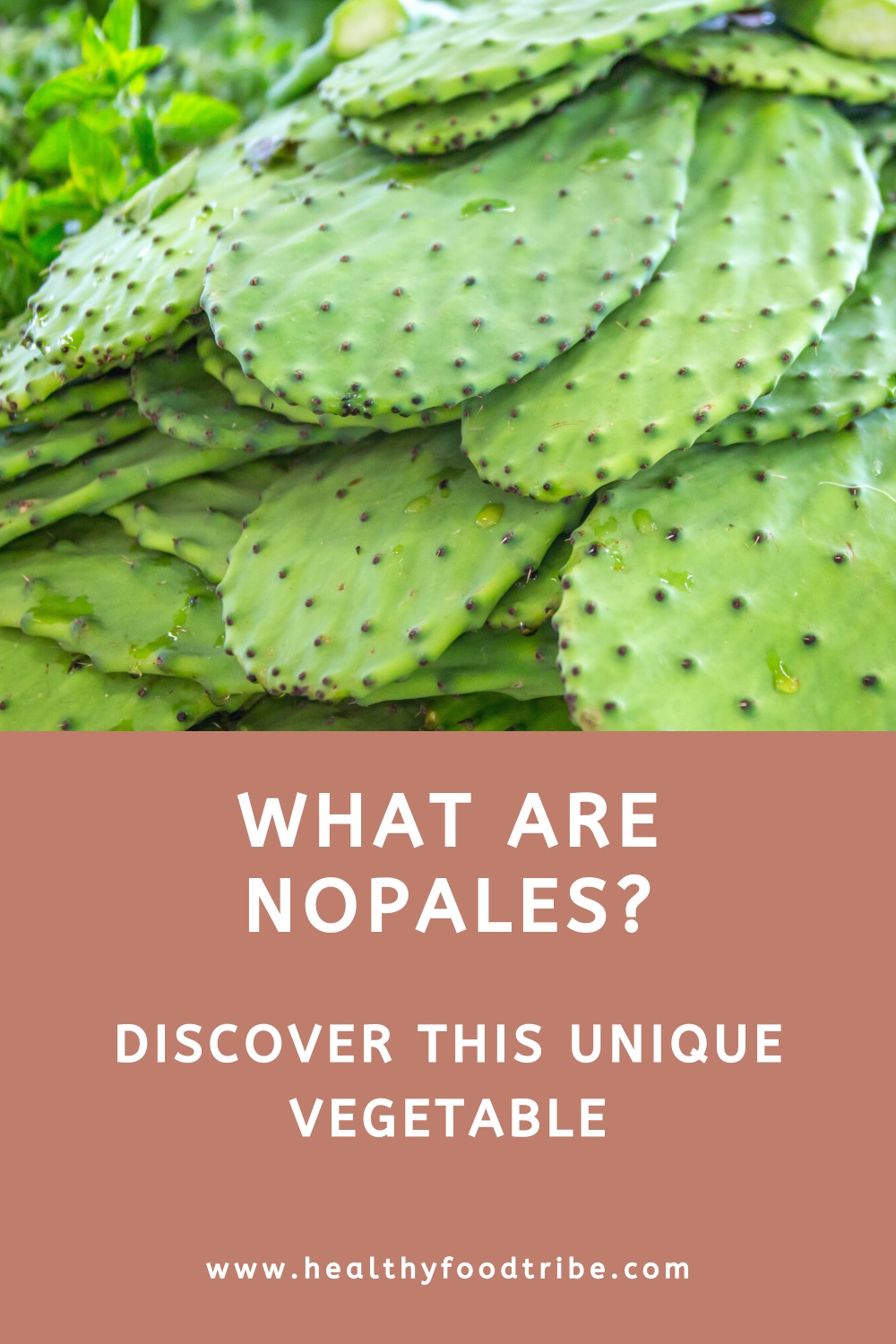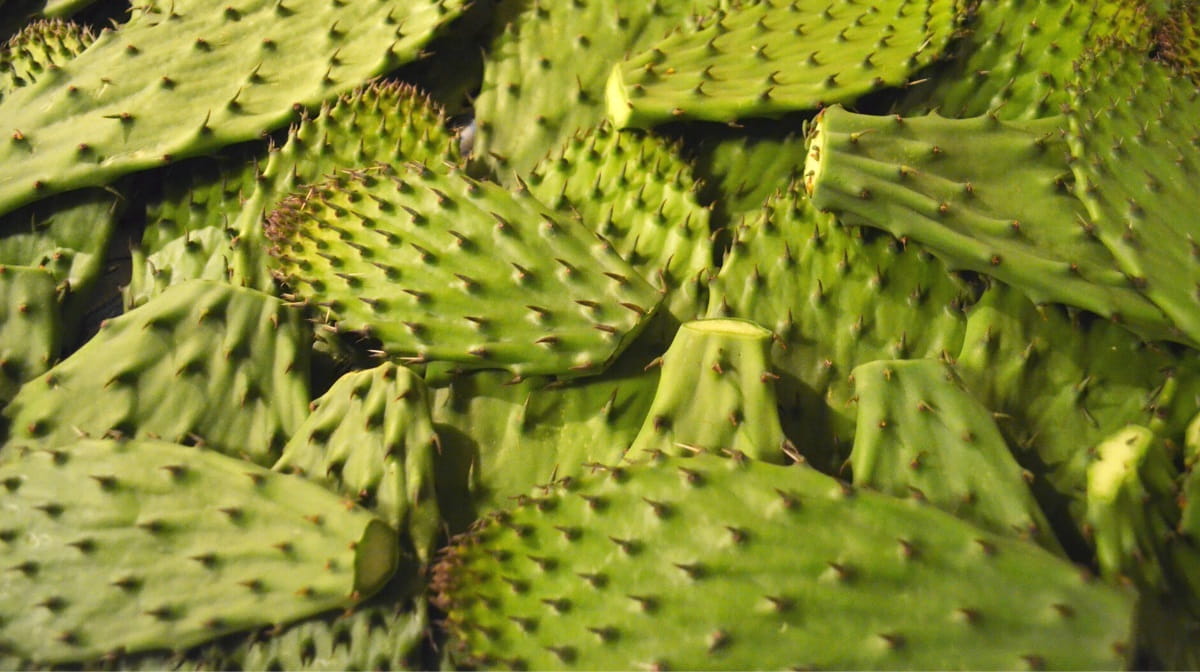Last updated: June 15, 2023
What are nopales? This guide explains the history, origins, nutritional profile, and benefits of nopales, a unique vegetable from the Mexican nopal cactus.
I had never heard of nopales until I discovered this unique vegetable a little while back. And I have become so excited about nopales and the nopal cactus that I now try to eat it regularly.
Keep reading, as I am going to reveal everything I know about nopales, where they originate from, what nutrients they offer, and so much more!
Quick navigation:
What Are Nopales?
To answer the question “what are nopales”, let me tell you a little story about how I first discovered this versatile vegetable a few years ago.
“What? You eat THOSE?”, I asked when I first laid my eyes on nopales.
In front of me, in the Mexican grocery store only a few blocks from where I used to live, is a large basket full of bright green cactus paddles. “Nopales”, says the price tag. Abundant and cheap, $0.99 a pound.
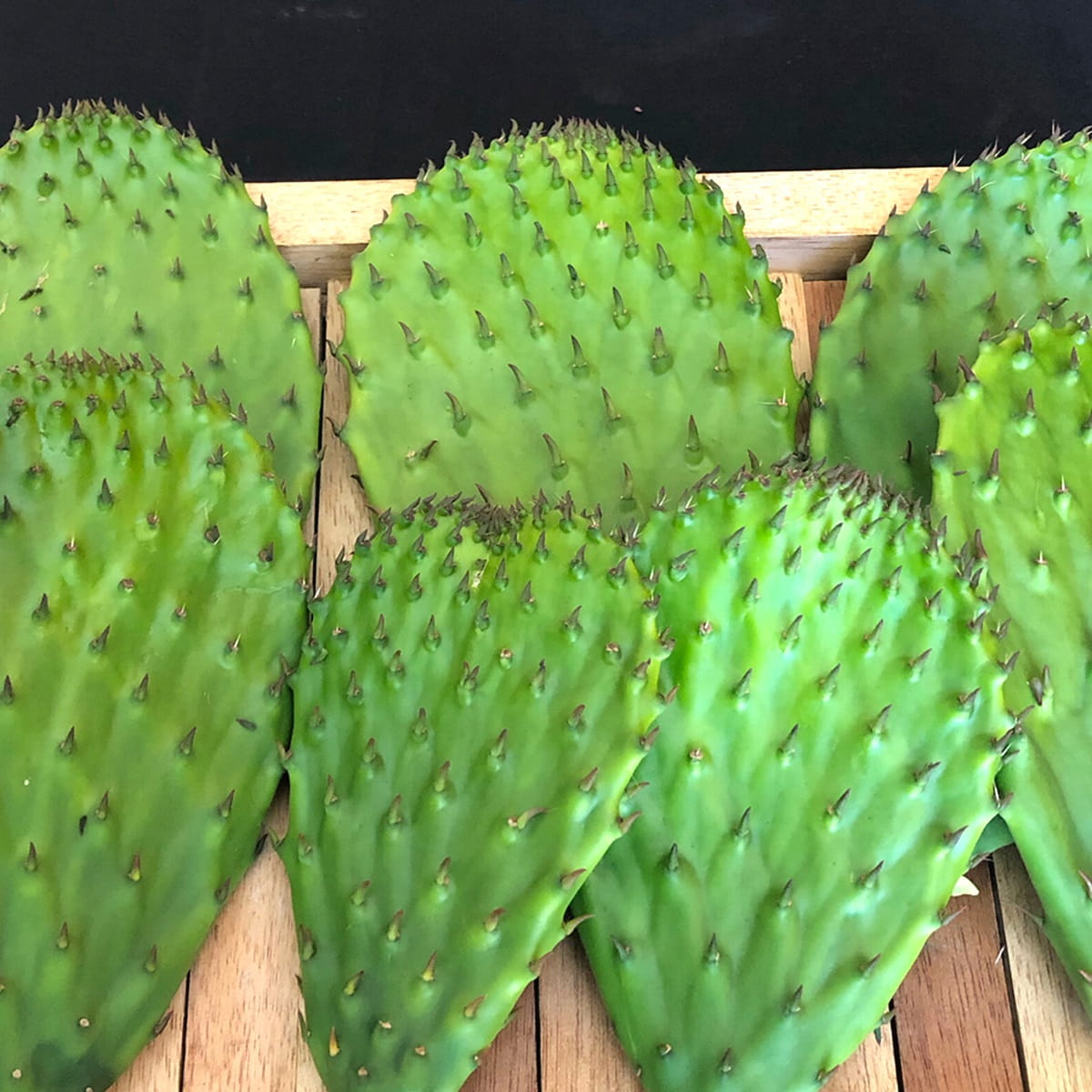
“Yes, we eat them! They are tasty, refreshing, and packed with antioxidants, vitamins, and minerals”, the lovely shop attendant smiles at me. She explains to me that she is a student of ethnobotany of Mexican origins.
“Nopales are really good for you, and they can help you lose weight! You can also use them as a natural cosmetic for your skin and hair. What more can you ask of a cactus?” Good point.
Nopales Are a Vegetable
I already knew a little about the Nopal cactus, otherwise known as Opuntia ficus-indica, if you like scientific names. We picked prickly pears from it on a beach in Sicily on a holiday many years ago.
No chance to take the kids to Italian beaches any time soon, so I wanted to give them at least a taste of the Mediterranean, and all those lovely vitamins that the prickly pears are packed with. Sometimes they have it on sale here, among Mexican specialties, labeled as “tuna”.
What I didn’t know is that the cactus paddles are food too!
History of the Nopal Cactus
“The fruit of the nopal cactus is the heart of Copil, a great warrior and sorcerer. He was killed in a terrible power fight with the sun god Huitzilopochtli and his heart was cut out and thrown into a lake.”
“A cactus grew from it. See that?” Rosa, the shop attendant, points to a large Mexican flag on the wall. And there it is, the nopal cactus, right in the center. A large eagle is perched on it, eating a serpent.
“That is the symbol of the city of Tenochtitlan, where cactus pear grows on stone, today’s Mexico City. The legend says that the wandering Mexica founded the capital of their empire following a prophecy. They had to find an eagle sitting on the cactus that grew from Copil’s heart.”
Where nopales grow, that is a good place to live. A piece of ancient wisdom that makes absolute sense: abundant food and medicine within reach.
The Conquistadores Brought Nopales to Europe
I learned much more from Rosa. The prickly cactus is also called la planta de vida (the life-giving plant) because it regrows from fallen pads that root easily.
“But wasn’t this cactus imported from Italy?”
“No! It’s the other way around. It traveled to the Mediterranean with the conquistadores.”
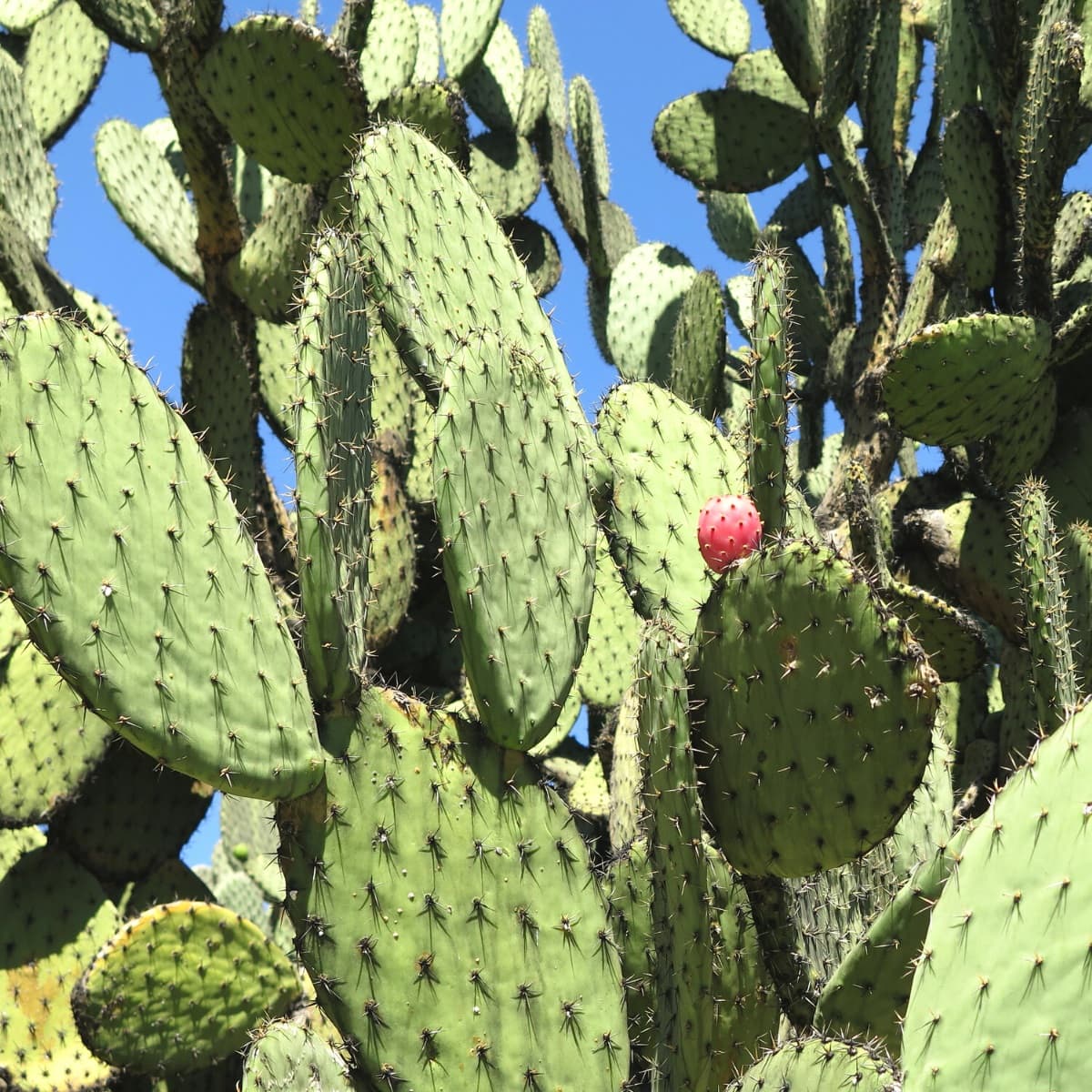
Another fascinating story, this time from a historic chronicle: the Spanish navy learned to use the life-giving plant to save their sailors from scurvy. A lack of vitamin C can kill you if you are at sea for months without fresh fruit and vegetables to eat.
The prickly cactus is packed full with vitamin C. This is why Spanish ships started to stock up with its fruit and paddles to consume on long journeys.
As a product from the “New Indies”, it was called Indian Fig. Barbary Fig, mission cactus, and cactus pear all refer to the same plant.
The conquistadores took the nopales to Spain, and to the whole Mediterranean. From there, the prickly cactus conquered the world, settling happily wherever there are arid or semi-arid regions.
The Nopal Cactus Creates Wealth
Today the nopal cactus is big business. In Mexico, it is the engine of an industry worth 150 million dollars that gives jobs to 10,000 people.
There are many more countries that grow Opuntia ficus-indica commercially:
China, India, Brazil, Italy, Spain, Portugal, Greece, Tunisia, Morocco, Algeria, Lebanon, Jordan, Egypt, Israel, Chile, Turkey, Bulgaria, Ethiopia, and South Africa, to name a few. Oh, and the United States also!
The fact is that everybody is discovering the benefits of eating cactus. Who would have guessed?
How to Eat Nopales?
Nopales can be eaten raw, but most people cook or grill them and then add them to Mexican dishes, such as tacos, soups, and salads.
For more information on this, read my guide on how to cook nopales, with a step-by-step recipe for cooking nopales and other delicious recipes with this nutritious vegetable.
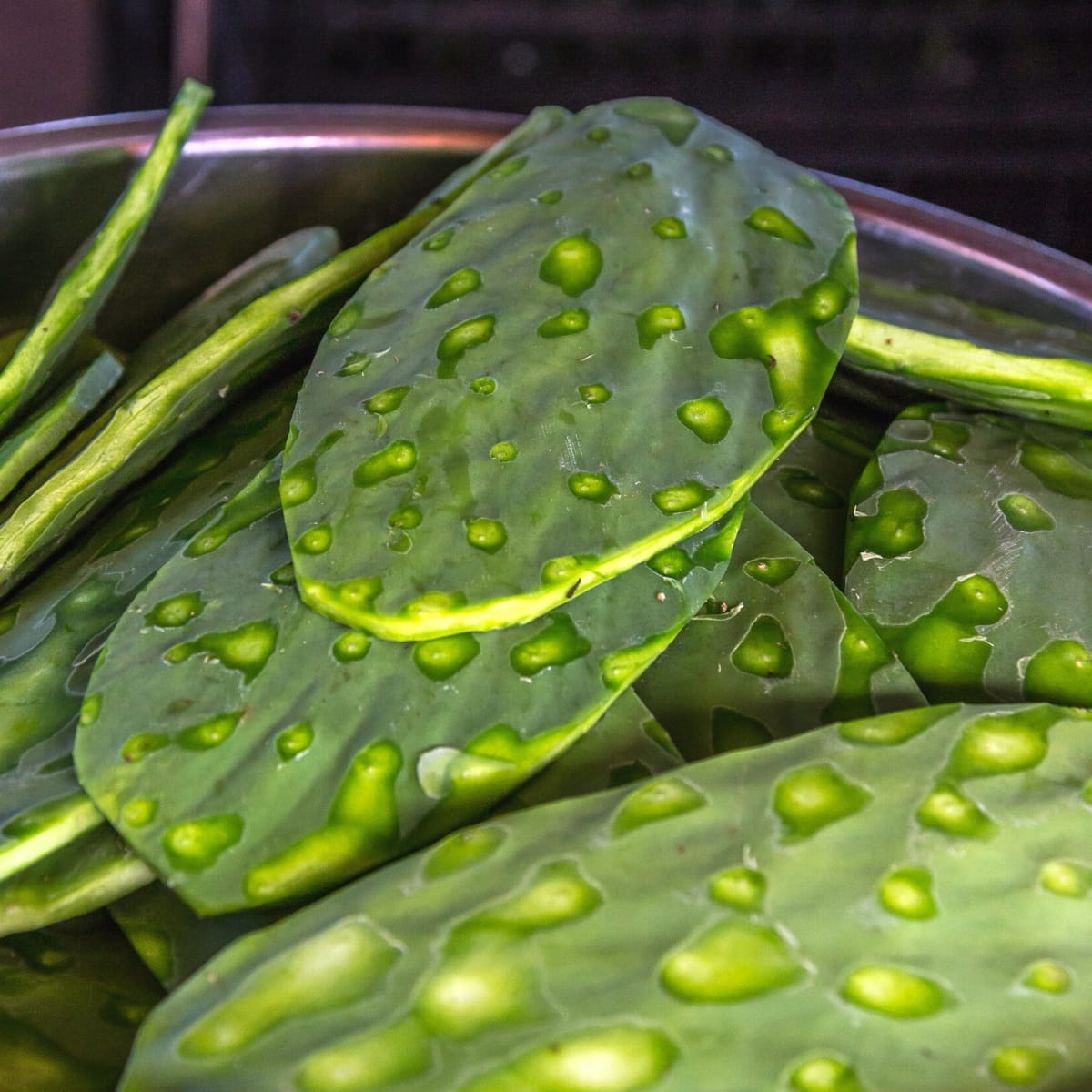
“Let me clean these for you”, Rosa says.
Great idea. I have a vivid recollection of painful, hair-like thorns sticking in my fingers for days. Picking prickly pears in Sicily came at a price.
Both paddles and fruit have long, hard barbed thorns plus the “glochids”, those furry and fluffy white spots that are vicious micro torturers. They pierce your skin at the slightest touch, break easily, and you go crazy removing them. Better leave the cleaning to an expert.
A lighter appears in Rosa’s right hand. She swiftly burns off both types of thorns and removes the “eyes” on the paddle with a sharp knife. Then she trims the edge of the nopal and gives it a good wash.
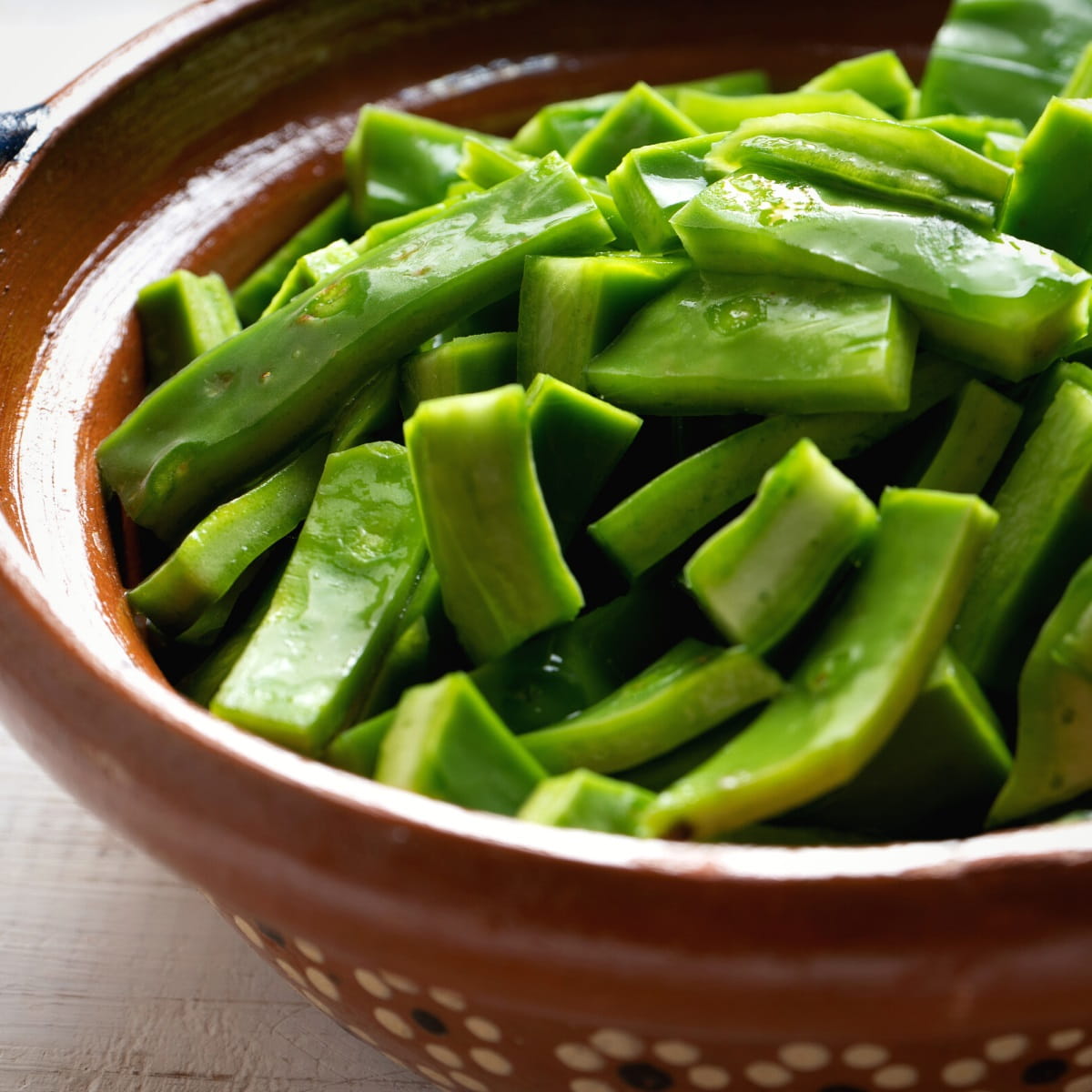
“It’s important to try and keep as much of the skin as possible. For taste and nutrients too”, she explains. She cuts a strip from the paddle and offers it to me on the knife’s tip.
“Try it. Always choose smaller, greener nopales like this one. The larger and older ones are fibrous and bitter. Pick paddles that are tender but firm, not flabby.”
What Do Nopales Taste Like?
Slightly citrusy. Crunchy and a bit squishy at the same time. A mix of asparagus and French beans, perhaps a bit like raw bell pepper too.
“Boil them for ten minutes if you don’t like the gel. You can add some vinegar too”, Rosa suggests.
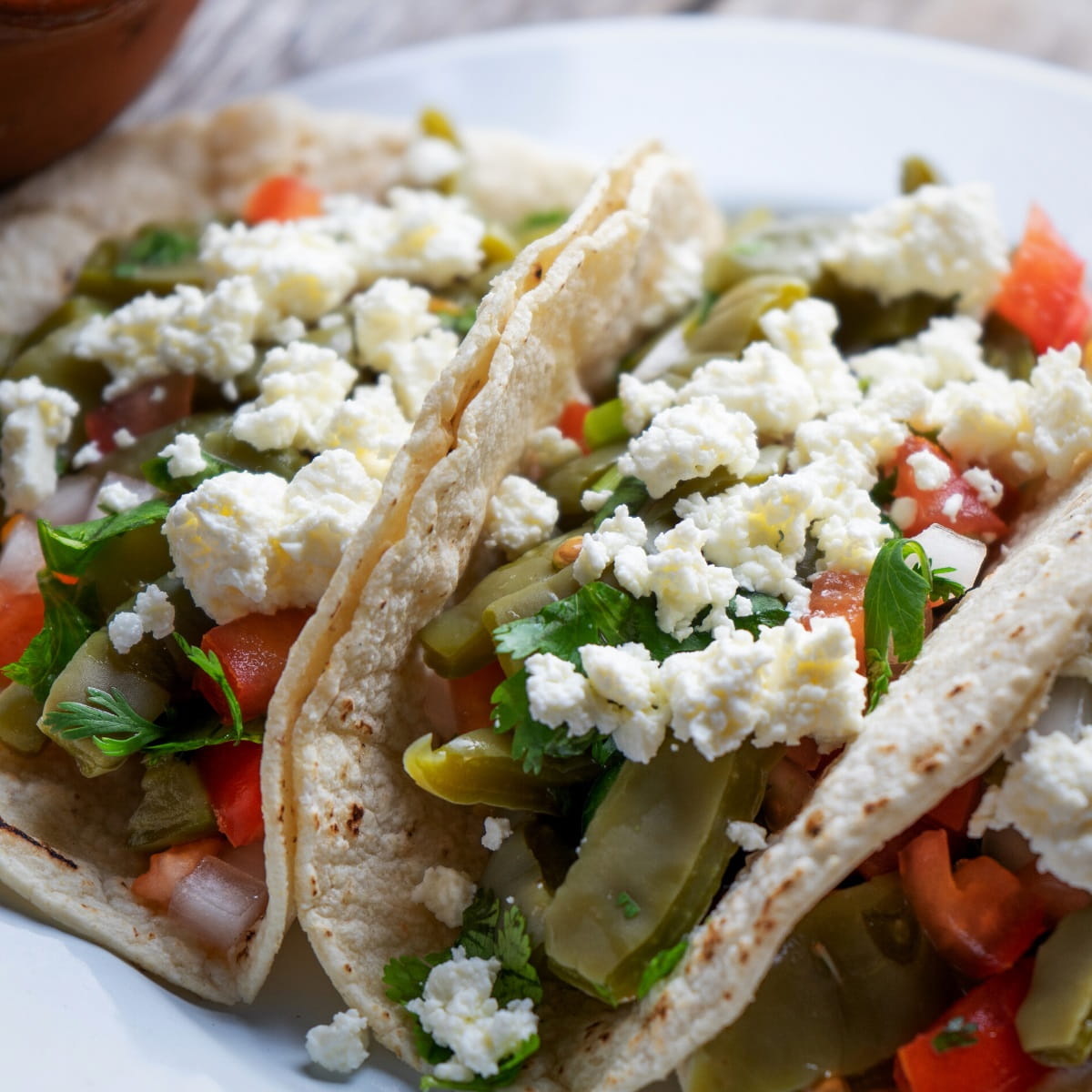
“But if you want the strongest health benefits, eat them raw. Make a smoothie. Blend them with diced pineapple or cucumber, mix them with a little orange juice. Add them to salads. Or eat them for breakfast with scrambled eggs, nopales con huevos is a Mexican classic.”
Great for my early morning energetic breakfast! Running or cycling is something that I do best when the family is still sleeping. Scrambled eggs are a favorite of mine; they are ready in a flash and give me an energy boost. I always top them with delicious fresh vegetables.
Welcome to my menu, nopales!
Nutritional Profile and Benefits
What do the official sources say about the nutritional value of the nopal cactus? I paid a visit to the Food Data Centre of the U.S. Department of Agriculture.
They have measured the nutrients in 100 grams for cooked/unsalted and for raw nopales. Some items caught my eye. I singled these out, and I put them in this little table for you:
| Nopales Nutritional Profile | ||
|---|---|---|
| Cooked (100 g) | Raw (100 g) | |
| Water | 94.31 g | 94.12 g |
| Energy | 15 kcal (1% DV) | 15 kcal |
| Protein | 1.35 g (3% DV)) | 1.32 g |
| Fat | 0.05 g (0% DV) | 0.09 g |
| Cholesterol | 0 g (0% DV) | 0 g |
| Carbohydrates | 3.28 g (1% DV) | 3.33 g |
| – Dietary fiber | 2.0 g (9% DV) | 2.2 g |
| – Sugars | 1.12 g (2% DV) | 1.2 g |
| Minerals | ||
| Calcium | 164 mg (13% DV) | 164 mg |
| Magnesium | 47 mg (12% DV) | 52 mg |
| Manganese | 0.4 mg (20% DV) | 0.457 mg |
| Potassium | 195 mg (5% DV) | 257 mg |
| Sodium | 20 mg (1% DV) | 21 mg |
| Vitamins | ||
| Vitamin A (RAE) | 443 IU (15% DV) | 457 IU |
| Vitamin C | 5.3 mg (10% DV) | 9.3 mg |
| Vitamin K | 5.1 mcg (6%) | 5.3 mcg |
| Source: USDA (raw nopales) en USDA (cooked nopales) | ||
The Percent Daily Values (DV %) come from this handy calculator. This is a helpful tool I use to find out the nutritional profiles of different foods.
DV % is so helpful because it tells you what percentage of the recommended intake of specific nutrients that you can get from a serving of any particular food. The standard considered for a daily diet is 2,000 calories a day.
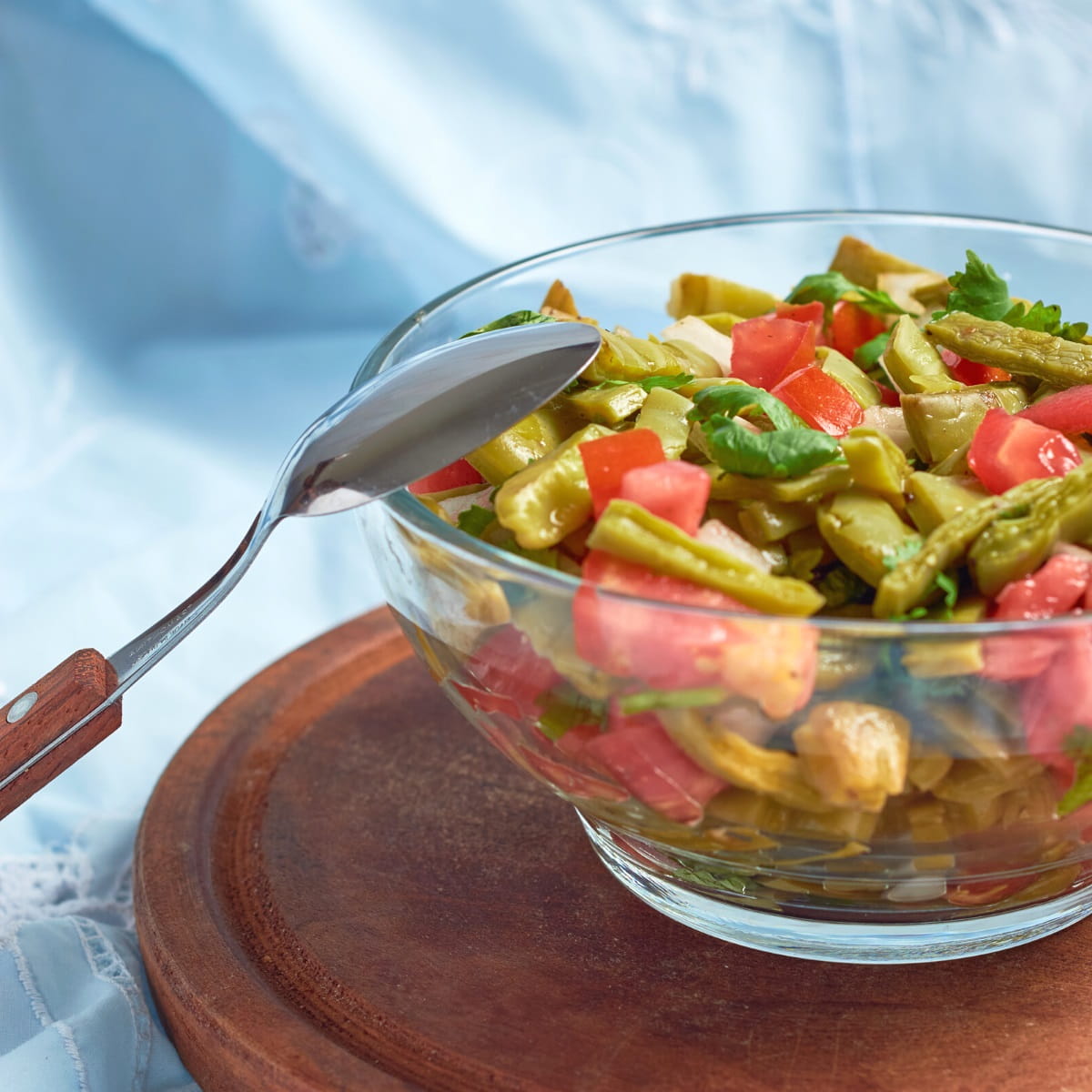
I am not a nutritionist, but I like to know what I eat and what it does to my body. The numbers above tell me that nopales are a very clean vegetable:
- Mostly water
- An interesting quantity of dietary fiber
- No cholesterol
- Hardly any fats
- Negligible amounts of carbohydrates and sugars
- Extremely low quantity of calories produced
So what does this all mean? If you need an energy boost, nopales are not your best option. Nor to build muscle because they have very little protein.
But if you need to supplement vitamins C, A, and K, this is definitely an excellent veggie to add to your diet. In that regard, I could add nopales to my list of favorite veggies high in vitamin K.
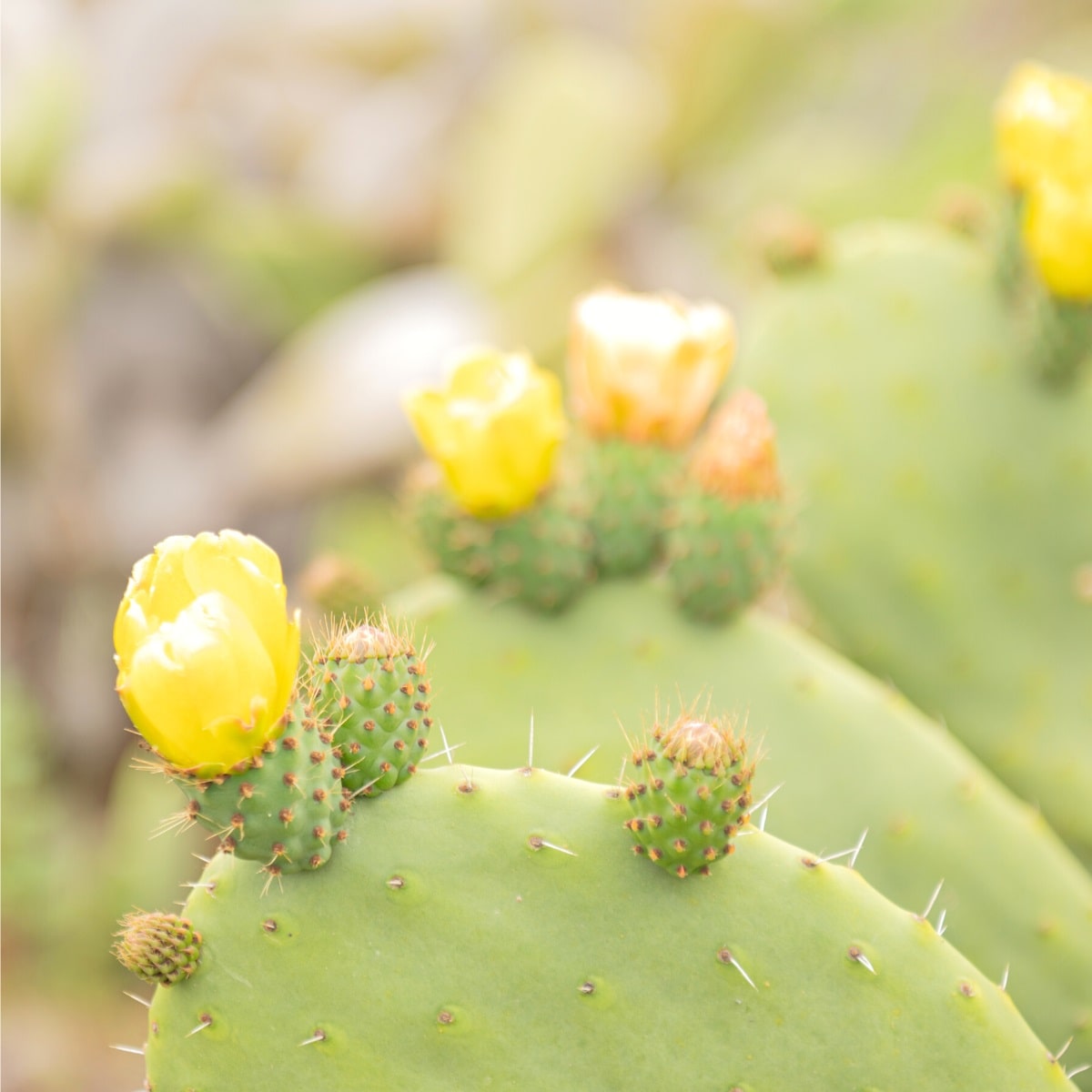
If you need more manganese, magnesium, and calcium, then eat nopales. Potassium is a whole chapter by itself; I will write more on its benefits in the next section.
See the comparison between cooked and raw values in the table: part of the vitamins and minerals are lost when cooking the paddles. Nearly half the vitamin C is gone! That’s one argument in favor of raw nopales in smoothies and salads, as suggested by Rosa.
Benefits of Eating Nopales
As for me, I have decided to add the prickly cactus to my diet. The following three benefits of eating nopales are more than sufficient.
1. Rich in Potassium and Poor in Sodium
Nopales are rich in potassium and poor in sodium, and that can help you keep your blood pressure in good shape.
The CDC (Centers for Disease Control and Prevention of the U.S. government) says that you can get high blood pressure by consuming too much sodium and not enough potassium. Read their article on sodium, potassium, and health for more information.
Medical News Today says that adults should consume 4,700 mg of potassium a day, but less than 2% of people in the U.S. do so. Even worse, people in the U.S. eat abysmal quantities of sodium from processed food.
2. They Fit in a Weight Loss Diet
Nopales can make you feel satiated (the fibers!) while producing a ridiculously low amount of calories. Good for losing weight? Definitely.
Their high amount of potassium is another positive factor because it helps regulate fluids around our cells and prevent water retention. That can mean three to five pounds of extra weight. And make us feel bloated.
3. Rich in Dietary Fiber and Managanese
In Mexico, nopales are often used as a way to deal with diabetes. Thanks to the dietary fiber, that mops up a lot of excess sugar and removes it from the bloodstream.
We get too much sugar in our diet, again from processed foods. Whatever can fix that is most welcome on my table!
The high concentration of manganese in nopales is beneficial too. Manganese deficiency is associated with diabetes.
Final Thoughts
So there you have it. Who would have thought that one cactus could be so fascinating in so many different ways?
I strongly encourage you to go out there and try and find nopales. They are a unique and versatile vegetable, and I’m sure you will appreciate them as much as I currently do.
But before you go, make sure you read my list of weird and unique vegetables for more interesting things you can eat!
